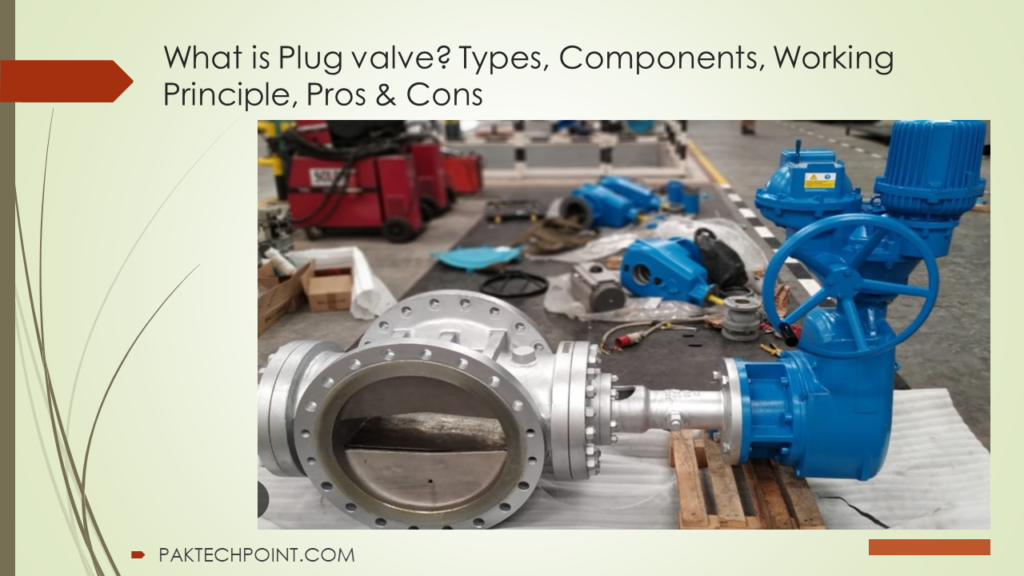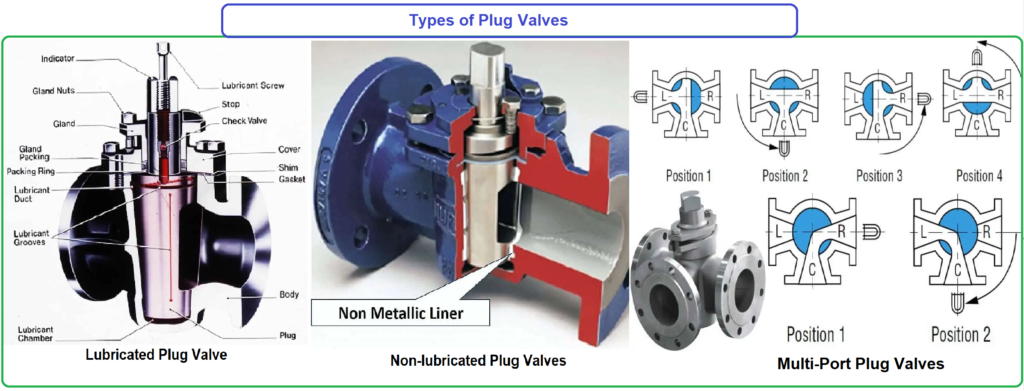A plug valve is a quarter-turn rotary motion valve that utilizes a cylindrical or tapered plug to control the flow of fluids. It offers a straight passage for fluid with minimal turbulence and can be fully open or closed. Plug valves are versatile and find applications in various industries. They are known for their quick operation, bubble-tight seal, and suitability for on-off control. However, they are not ideal for extensive throttling and may require maintenance due to potential wear. Different types of plug valves cater to specific needs, such as lubricated, non-lubricated, eccentric, and lined designs.

What is Plug Valve?
A plug valve is a type of quarter-turn valve that uses a cylindrical or conical plug to control the flow of liquids or gases through a pipeline. The plug has a passage or bore that can be rotated within the valve body to either allow or block the flow of fluid. Plug valves are known for their simple design, ease of operation, and ability to provide tight shut-off, making them suitable for a wide range of applications across various industries.
Read Also: How to do Technical Purchase Specification for Ball, Butterfly, and Plug Valves
Key Components and Working Principle:
A plug valve consists of several main components:

- Body: The valve body is the outer casing that encloses the plug and other internal components. It has inlet and outlet ports for fluid entry and exit.
- Plug: The plug is a cylindrical or conical component with a passage or bore through its center. The plug can be rotated within the valve body to control the flow of fluid. When the plug’s passage aligns with the flow path, fluid can pass through the valve; when the plug is rotated to block the passage, the flow is shut off.
- Stem: The stem is connected to the top of the plug and extends through the top of the valve body. It is used to rotate the plug and control the valve’s operation. The stem can be operated manually with a lever or handwheel or automated with an actuator.
- Handles or Actuators: Handles or actuators are used to operate the valve. In manual valves, a lever or handwheel is used to turn the stem and rotate the plug. In automated valves, electric, pneumatic, or hydraulic actuators are used to control the valve’s operation.
- Seals and Packing: Seals and packing materials are used to provide a tight seal between the plug and the valve body, preventing leakage when the valve is closed.
Working Principle:
- Open Position: When the plug valve is in the open position, the plug’s passage aligns with the flow path, allowing fluid to flow through the valve without obstruction. The plug is rotated 90 degrees from the closed position to the open position.
- Closed Position: When the plug valve is in the closed position, the plug is rotated 90 degrees so that its passage is perpendicular to the flow path. This blocks the flow of fluid and prevents it from passing through the valve.
Types of Plug Valves:
There are various types of plug valves, each designed to cater to specific applications and requirements:

- Lubricated Plug Valve: This type of valve uses a lubricant to reduce friction between the plug and the valve body, making it easier to operate. Lubricated plug valves are suitable for applications where tight shut-off is required.
- Non-Lubricated Plug Valve: Non-lubricated plug valves do not require external lubrication. Instead, they use materials such as Teflon or other self-lubricating materials to minimize friction.
- Sleeved Plug Valve: In a sleeved plug valve, a flexible sleeve or lining is fitted inside the valve body. The plug moves within the sleeve, providing effective sealing and reducing contact with the valve body.
- Eccentric Plug Valve: Eccentric plug valves have an off-center plug design that reduces wear and friction during operation. These valves are suitable for applications involving slurries or fibrous materials.
- 3-Way Plug Valve: A 3-way plug valve has three ports and is used to divert or combine flows from two separate sources.
- Expandable Plug Valves: Expandable plug valves are a specialized type of valve designed to provide efficient sealing and prevent product contamination in various industrial applications. These valves are particularly suitable for situations where double isolation is not necessary but where effective sealing is still a critical requirement. They offer a unique design and operating principle that sets them apart from conventional plug valves, making them valuable assets in industries ranging from chemical processing to oil and gas.
Plug Valves Port Patterns:
Plug valves come with various port patterns to suit different flow requirements and applications:
- Round Opening: This design features round ports in both the plug and the body, providing a smooth flow path.
- Rectangular Opening: Utilizing rectangular ports in the full bore section, this pattern offers efficient flow control.
- Standard Opening: The valve’s flow area is smaller than the standard pipe area, ensuring controlled and directed flow.
- Diamond Opening: With a diamond-shaped opening configuration, this design optimizes fluid movement through the valve.
- Multi-Port: These valves come with three or more pipe connections, enabling versatile transfer of services.
- Venturi Design: Featuring a reduced area opening that creates Venturi flow, this design enhances fluid velocity and control.
Each port pattern caters to specific flow characteristics, making plug valves adaptable for a wide range of industrial applications.
Read Also: VALVE SEAT LEAK TEST PROCEDURE | METHOD STATEMENT
Which international codes and standards are used plug valves design?
Plug valves are designed and manufactured in accordance with various international codes and standards to ensure their quality, safety, and compatibility with different industries. Some of the prominent codes and standards used for plug valve design include:
- API 6D: This American Petroleum Institute standard specifies requirements for design, manufacturing, testing, and documentation of pipeline and piping system plug valves used in the petroleum and natural gas industries.
- API 599: Another API standard, API 599 covers requirements for metal plug valves used primarily in the oil and natural gas industries. It includes dimensions, design, materials, marking, testing, and inspection guidelines.
- ASME B16.34: This standard from the American Society of Mechanical Engineers (ASME) provides specifications for valves, including plug valves, in terms of design, materials, pressure-temperature ratings, and testing.
- ISO 14313: This International Organization for Standardization (ISO) standard outlines requirements for the design, testing, and inspection of pipeline transportation systems using plug valves.
- MSS SP-61: The Manufacturers Standardization Society of the Valve and Fittings Industry publishes this standard, which covers high-pressure chemical industry flanged and butt-welded plug valves.
- EN 13709: Published by the European Committee for Standardization (CEN), this standard specifies requirements for cast and forged steel plug valves primarily used in petroleum and natural gas industries.
- BS 5353: This British Standard provides specifications for steel plug valves for use in the petroleum, petrochemical, and allied industries.
- DIN 3357: The German Institute for Standardization (DIN) standard defines requirements for straightway pattern and angle pattern plug valves.
These codes and standards ensure that plug valves are designed, manufactured, and tested to meet specific quality and performance criteria. Manufacturers, suppliers, and users of plug valves rely on these standards to ensure consistency, compatibility, and safety across various applications.
Advantages of Plug Valves:
Plug valves offer several advantages that make them suitable for different applications:
- Quick Operation: Plug valves can be quickly turned on or off with a 90-degree rotation.
- Tight Sealing: The plug’s design allows for tight shut-off, preventing leakage when the valve is closed.
- Simplicity: The simple design of plug valves means fewer components and less maintenance.
- Versatility: Plug valves can handle a wide range of fluids, including abrasive and corrosive materials.
- Economical: Their straightforward construction makes plug valves cost-effective compared to other valve types.
- High Flow Capacity: The straight-through design of the plug valve provides high flow capacity and low pressure drop.
Difference Between Plug Valve and Ball Valve
Here’s a comparison between Plug Valves and Ball Valves based on various aspects:
| Aspect | Plug Valve | Ball Valve |
|---|---|---|
| Valve Type | Rotary Motion Valve | Rotary Motion Valve |
| Closure Mechanism | Cylindrical or Tapered Plug | Spherical Ball |
| Flow Control | On-off and Throttling | Primarily On-off |
| Port Pattern | Round, Rectangular, Standard, Diamond, Multi-port, Venturi | Full, Reduced, V-Port |
| Minimum Turbulence | Good | Better |
| Design Simplicity | Simple | Relatively Complex |
| Leakage Prevention | Good | Excellent |
| Flow Direction | Bidirectional | Bidirectional |
| Application Range | Low to Moderate Pressure/Temperature | Low to High Pressure/Temperature |
| Corrosion Resistance | Suitable for Corrosive Fluids | Suitable for Corrosive Fluids |
| Maintenance | Easy | Generally Easy |
| Sizes | Up to 18 inches | Various Sizes Available |
It’s important to note that both plug valves and ball valves have their own advantages and are suitable for different applications based on factors such as pressure, temperature, flow control requirements, and fluid compatibility. The choice between these valves depends on the specific needs of the application.
Plug Valve Manufacturing Materials
Indeed, plug valves can be manufactured using a range of materials to suit diverse application requirements. The choice of materials depends on factors such as the nature of the fluid, pressure, temperature, and corrosive properties. Here are some commonly used plug valve materials:
- Steel: Carbon steel is often utilized for plug valves due to its general strength and compatibility with a variety of fluids. It’s suitable for moderate pressure and temperature applications.
- Stainless Steel: Stainless steel offers enhanced corrosion resistance compared to carbon steel. It’s used when dealing with corrosive fluids or environments.
- Bronze: Bronze is a popular material choice for plug valves, particularly in applications involving seawater or marine environments. It offers good corrosion resistance and durability.
- Brass: Brass is valued for its favorable machinability and resistance to dezincification, making it suitable for certain water and gas applications.
- Plastic: In cases where chemical compatibility or non-corrosive properties are critical, plug valves can be constructed from plastic materials such as PVC, CPVC, or PTFE. These materials are often used in water treatment, chemical processing, and similar applications.
- Alloy Materials: For specialized applications where higher resistance to extreme temperatures or specific corrosive agents is required, alloy materials like Monel, Inconel, or Hastelloy might be used.
- Coated Materials: Various coatings such as epoxy, PTFE, or rubber can be applied to the valve’s internal and external surfaces to enhance corrosion resistance and extend the valve’s service life.
The selection of the appropriate material is crucial to ensure the plug valve’s longevity, performance, and reliability in the intended application. Factors like fluid characteristics, operating conditions, and maintenance considerations play a significant role in making the right material choice for a plug valve.
Applications:
Plug valves find applications in various industries and environments due to their versatility and reliable performance. Some common applications include:
- Water treatment and distribution
- Chemical processing
- Oil and gas pipelines
- Petrochemical industries
- Power generation
- Pulp and paper manufacturing
- Food and beverage processing
- Waste management and sewage treatment
The choice of plug valve type depends on factors such as the nature of the fluid, pressure, temperature, flow rate, and the specific requirements of the application. Plug valves are selected based on their ability to provide effective shut-off and control in diverse operating conditions.
Following video representing full technical guide about Plug Valves.